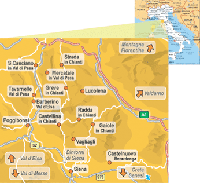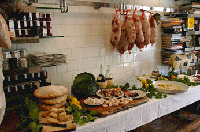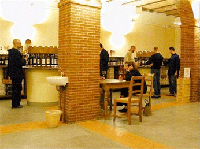Tutta Bella in Tuscany
The Hartman Group’s anthropologists, sociologists, and culinary professionals travel extensively on immersions into the lifestyles and food cultures around the world. Here’s a story on an immersion in Italy.
By Melissa Abbott, Senior Director, Culinary Insights
 We set off over the Atlantic, making our way to the land of Chianti Classico and Pecorino Romano cheese, to learn a bit about food culture from the masters in Italy. Instead of hitting the big destinations like Rome, however, we chose to take a backroads walking tour and eat our way through Italy to find out what insights we could glean from a culture raised not just on food, but food passion. So, after restoring ourselves from the flight with a bit of roasted porchetta and salt-cod-stuffed zucchini blossoms, we headed to Siena where we began our epic hike through the vineyards, olive groves, and woodlands of Tuscany towards Florence. We loved taking our time exploring Italian culture as we walked all day through hills and valleys, far away from the throngs of tourists. Each evening we arrived at the next villa where our luggage, transported by a porter, was waiting for us and our well-worn limbs and grumbling bellies.
We set off over the Atlantic, making our way to the land of Chianti Classico and Pecorino Romano cheese, to learn a bit about food culture from the masters in Italy. Instead of hitting the big destinations like Rome, however, we chose to take a backroads walking tour and eat our way through Italy to find out what insights we could glean from a culture raised not just on food, but food passion. So, after restoring ourselves from the flight with a bit of roasted porchetta and salt-cod-stuffed zucchini blossoms, we headed to Siena where we began our epic hike through the vineyards, olive groves, and woodlands of Tuscany towards Florence. We loved taking our time exploring Italian culture as we walked all day through hills and valleys, far away from the throngs of tourists. Each evening we arrived at the next villa where our luggage, transported by a porter, was waiting for us and our well-worn limbs and grumbling bellies.
Meandering through remote villages allowed us to taste foods, drink wines, and engage in customs we never would have experienced in larger cities. What we found particularly interesting is that Italians eat their fair share of pork, full-fat dairy, pasta, and white bread, of all things, yet their waistlines do not correlate to ours here in the States, despite our avoidance of white carbohydrates and fatty animal products. It was clear that Italians take more time to prepare their meals and make the effort to come to the table with their families and friends. Portions are smaller. A lot smaller. The scoops of intensely flavored gelato at Vestri in Florence wouldn't even pass for kiddy size here at home. Even with the smaller portions, we managed to eat quite well.
Dievole Vineyards and Villa
Our first destination from Siena was to Villa Dievole, a working vineyard set on an old country estate. The Dievole Vineyards have been planted with grapevines since 1090, when the area was known as "the divine valley." Today, the estate's 750 acres include 16 vineyards, each cultivated by an individual vintner. A bottle of Dievole's Chianti Classico Reserve was included with a welcome note in our room upon our arrival. Needless to say, we were very happy at Dievole.
As with most of the fare in Tuscany, Dievole’s food was rustic and traditional, lacking in pretense. The local olive oil, cheeses, and salumi were incredible, as was their simple tagliatelle with tartufo (truffles made their way into many a pasta dish in Tuscany). At breakfast, we inquired about a particularly delicious salumi and learned it was cinghiale (pronounced 'ching-GYAH-lay'), which is wild boar. Cinghiale is similar to pork but more tender and with an earthier flavor. This hearty animal can be found rooting through the Tuscan countryside, competing with farmers for the best mushrooms and gobbling their grapes and olives. Cinghiali have been respected since Roman times for their strength, courage, ferocity, and as a Tuscan delicacy.
We were warned about the ferocious cinghiale living in the woods we would soon be trekking through. Several days later, as we were ascending a forest path, we came upon a huge mama cinghiale and her not-so-little babies. One glimpse of her mighty tusks and we forgot all about our sore toes and ran upwards and out of her path. That very evening, we tucked into a most complex ragu with perfectly executed bucatini. The ragu in question was in fact a local specialty, ragu de cinghiali. Further evidence to always go with the house special.
Panzano
 Antica Macelleria Cecchini, a butcher shop that has stood the test of time.
Antica Macelleria Cecchini, a butcher shop that has stood the test of time.Another noteworthy spot on our Tuscan trek was the village of Panzano, referred to by locals as paese dei golosi, or "village of gourmands." Our favorite part of Panzano was the butcher. Okay, the famous butcher, the "Michelangelo of Meat," Dario Cecchini. Dario runs The Antica Macelleria Cecchini, a butcher shop that has stood the test of time: it's been in Dario's family for over 200 years.
To let you know how serious Dario is about his meat, a friend of ours was living in Italy a few years back and was in the process of purchasing a cut of his wonderfully marbled Chianti beef. Our friend, who happens to be a fabulous cook, inquired as to the best method to prepare the meat. Dario slowly put his hand on the meat and began to slide it back towards himself in a rescue attempt, now unsure of his customer’s cooking skills. It took some effort before Dario was convinced that the meat would be heading to a kitchen that would treat his product with the love and respect it deserved. Perhaps you’ve heard of Dario from Bill Buford’s adventurous tale as apprentice to a Dante-quoting butcher in his wildly successful book, Heat? Yep, same guy.
We arrived at Panzano's Macelleria on a Saturday afternoon and stepped into what seemed a private party. Dean Martin was playing overhead as locals were snacking on bruschetta and roast pork and sipping Chianti out of tumblers. As we quietly backed out of the door, one of Dario's employees offered us glasses of Chianti, ushering us towards the platter of bruschetta spread with a thin peppered layer of lardo (aka lard - Tuscan artisanal producers cure unrendered pork fat with salt and herbs and then age it within special Italian marble blocks). Thus began my new appreciation of pork fat. As I was taking my first bite, Dario, with arms outstretched, smiled at his customers (this was a regular Saturday occurrence - not a party) and shouted, "Tutta Bella!" I agree, Dario. Life is beautiful. Or maybe it was the lardo-Chianti fog.
Greve in Chianti
 Greve in Chianti's innovative wine dispenser, perfect for tastings.
Greve in Chianti's innovative wine dispenser, perfect for tastings.After Panzano, the next destination was Greve in Chianti. The walk took us through vineyards and olive groves and woodland forests, ending at Le Cantine di Greve in Chianti, an innovative wine cooperative dispensing vino tastings and estate olive oils in a very clever format. You buy a card worth 10, 20 or 30 euro and insert it in the slot at one of the many tasting bars in the cellar. Each wine costs a different amount and your card is deducted after each automatic pour. What a fabulous way to taste wines that cost over $100 here in the States and compare them with other highly regarded sips, such as Chianti Classico Riserva, super Super Tuscans, Brunello di Montalcino, and Vino Nobile di Montepulciano.
Without question, Italians are intensely passionate about their food. The notion of food quality is ingrained in every citizen from birth, naturally weaving the topic of food and eating well into daily conversation. From how the grain is milled into flour for pasta to very specific DOC methods for making cheese and pizza, all fosters a sense of pride and tradition we can only hope for our future generations. That said, we are catching on here in the States with our own artisanal producers, whose products are in fact rivaling some of the wines, cheeses, and salumi available in Italy.
But as a population we often lack the connection between food and the pleasure of gathering together and sharing meals, referred to as commensality, or fellowship at a common table. But a few American restaurateurs are seeking to fill this void by offering communal Sunday Suppers, where a la carte is ditched for the passing of platters and sharing from the same pot, so to speak. The growing DIY sect in the US has also made inroads via communal preparation and food sharing with organizations such as Soup Share and Canning Across America, but there remains plenty of opportunity, from meat to vegetable prep, for retailers and CPG manufacturers to assist consumers in their effort to share meals.
If the media is any indication, Americans are fast becoming highly functional in food-speak, but we now need to back up all that bravado by developing foundation culinary skills so communal eating becomes as second nature to us as it is in Tuscany.
